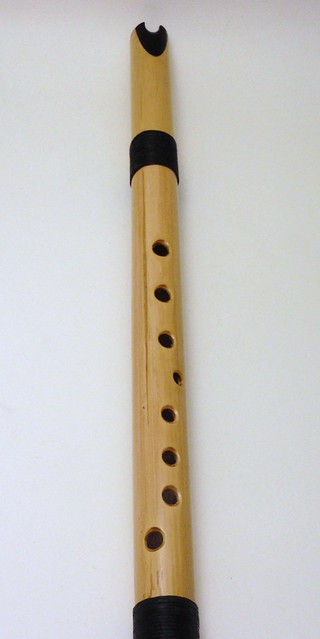I own three Quenas that most people would consider fairly high end instruments. They represent three quite distinct points in the design space. The first one I got is from Bolivia, made by Juan Acha. It is made from Cocobolo wood, has a large cylindrical bore, a semi-closed end at the bottom, and large tone holes. The second one is from Argentina, made by Un Mundo de Bamboo (which I abbreviate to UMB below). It is made from bamboo with a blackwood embouchure insert (plus various other tropical woods laminated). It is finished using some kind of clear epoxy, and has a conical bore, due to the natural taper of the bamboo, medium tone holes and a relatively narrow embouchure notch. The third one I got is from the USA, made by Geoffrey Ellis (http://www.ellisflutes.com/). It is made from Vera wood with an epoxy finish. It has a conical bore, more extreme than the Un Mundo de Bamboo flute, and relatively smaller tone holes. Its embouchure notch is the shallowest of the three, but wider than the UMB notch.
Here are some pictures (from left to right, in all three pictures: Ellis, UMB Acha):



Some stats:
Acha: bore cylindrical, 19.5 mm, closed at bottom with 11 mm opening. Top tone hole 12.5 mm. Embouchure 10.5 mm wide by 8 mm deep.
UMB: bore conical, 17.5 mm at top, 16 mm at bottom, open end. Top tone hole 9.5 mm. Embouchure 8.8 mm wide by 7.5 mm deep.
Ellis: bore conical, 18.5 mm at top, 12.5 mm at bottom, open end. Top tone hole 9 mm. Embouchure 10.7 mm wide by 6 mm deep.
Ok, so to the most important consideration: how do they play?
Not surprisingly, the Acha is the loudest of the three. It is fairly easy to play and has a nice tone, which I guess would be considered quite traditional. For my tastes it is a little too loud for indoor solo playing. Outdoors, or in a noisy room it would be great though. It takes some work to keep the volume balanced between octaves (higher being louder). The tone holes are very large, especially if you are used to playing irish flutes or whistles. This allows for expression, but it is also easy to have leaks until you adapt your technique. This might be an issue for people with small hands/fingers.
The UMB flute has a softer tone than the Acha, probably due to the bamboo and it being lighter. It is also breathier, but this might be me. I find its narrower embouchure harder to play. It is a little more balanced in volume between octaves than the Acha, but I find it a bit harder to play embouchure wise. The smaller finger holes still allow for expression, but are a little easier to close than the Acha. On balance, I prefer playing the Acha and I prefer the sound it makes.
The Ellis flute is very easy to play and has a very pure, clear sound. I'm not sure how traditional it is, but I really love the sound I get from it. It is exceptionally well in tune, considerably better than the other two, and is very well balanced across octaves. Its easy to slide between octaves as one would on a transverse flute. The smaller finger holes make the transition from irish flute or whistle playing very much easier than say the Acha. Again, a traditionalist might not like this, but personally I have a strong preference for it. This is my favorite of the three to play and to listen to indoors.
So, all three are very good quenas. The Ellis is exceptional, and in my opinion the best of the three, but it is more expensive than the other two. The UMB flute, which several people were very enthusiastic about in earlier threads is certainly good, but for my personal tastes, I prefer the Acha, which is less expensive and easier to obtain. Purchasing the UMB quena from Argentina was non-trivial for me living in the US. Purchasing the Acha from Bolivia was a little easier. Getting the Ellis quena was easy.

